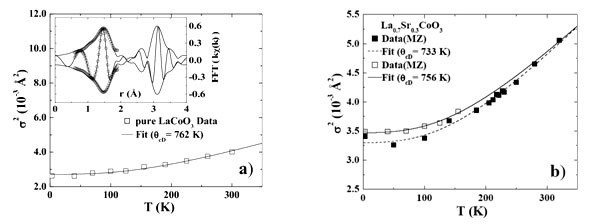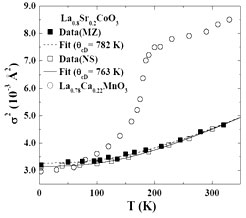

The transition metal oxides exhibit a wide range of interesting properties, of
which superconductivity in the copper oxides and colossal magnetoresistance in
the manganese oxides are perhaps the best known. However, the strange magnetic
behavior of several cobalt oxides is another example of these unusual
properties, although not yet as intensively studied. The cobaltite system
La1-xSrxCoO3 (LSCO) has a rich
temperature-concentration phase diagram with anti-ferromagnetism and insulating
behavior at low Sr concentrations, and ferromagnetism and metallic behavior at
higher concentrations. The magnetism for the end compound LaCoO3
(LCO) is particularly unusual; it has no Co spin magnetic moment at low T (and
is diamagnetic). As T increases from 4K, the magnetic susceptibility increases
dramatically up to roughly 100K, and then decreases as T is increased to 300K.
This behavior has been attributed to Co+3 having several different
spin configurations. Initially only two were considered, a low spin state (LS,
S=0) that is not magnetic and a high spin state (HS, S=2) that is strongly
magnetic. In the '90s a third, intermediate spin configuration (IS, S=1) was
proposed by Potze, et al. and Korotin, et al; this configuration should result
in a distortion of the CoO6 octahedra (called a Jahn-Teller (JT)
distortion). In the late '90s, Louca et al. reported neutron PDF results
indicating a distorted Co-O environment, comparable to the Mn-O distortions
observed in the similar manganite systems
La1-yCayMnO3 (LCMO) and
La1-zSrzMnO3 (LSMO). However,
to date, these neutron PDF data for the cobaltites are the only structural
results that support a JT distortion. While some recent experimental results
are argued to be consistent with a large Co-O JT distortion and its associated
IS state, many others appear to be inconsistent with such an interpretation.
Our group at UC Santa Cruz, therefore took a closer look at the possibility of
a JT distortion of the CoO6 octahedra, using a combination of the
EXAFS and neutron PDF techniques; here we focus on the Co K-edge EXAFS results,
for data collected at SSRL.
Before discussing Co, we first discuss three important energies that determine
the ordering of the energy levels, and hence the spin configuration. For the
free atom the 3d spatial states form a 5-fold degenerate multiplet, but in a
cubic crystal field, these states are split into 2-fold degenerate
eg and 3-fold degenerate t2g multiplets, with a splitting
energy called 10Dq. The second important energy is called the exchange energy,
Eex, which is roughly the energy to add a spin-down electron to a
state that is occupied by a spin-up electron. The third energy comes from the
Jahn-Teller (JT) interaction when there is only one eg electron
present. Then a local distortions about the Co ion, such as two long Co-O bonds
and four short Co-O bonds, will split the eg states (one state
decreases in energy and the other increases), and the electron can go to the
lower energy state if this distortion takes place - See Fig 1. Note that the
total energy is not lowered if two eg electrons are present. The distortion
does cost a small strain energy, but for eg states the net energy is
lowered and the crystal locally spontaneously distorts. When the energies 10Dq
and Eex are comparable, a tiny change in energy could change the
system from high spin to low spin (See Fig. 1) - and for one possible set of
energy levels (10Dq ~ Eex), including a JT distortion can lead to
the intermediate spin state.
For LCO, with six 3d electrons on Co, the filled energy states for the three
localized spin state models are: 1) LS -
t2g6eg0, with no eg
electrons and all six t2g spins paired (observed at low T); 2) HS -
t2g4eg2, expected at high T, note
that with two eg electrons it is not JT active; and 3) IS -
t2g5eg1, - with one eg
electron it should be JT active, creating Co-O bonds of different lengths in
the lattice. Thus a significant JT distortion is a signature for the IS state;
if such a distortion is observed, then the IS state must be included in
modeling the magnetism; however, if no JT distortion is present, no localized
states containing one eg electron exist and the IS state should not
be important.
Fig. 1. (Left) Diagram for Jahn-Teller splitting. The eg
states are doubly degenerate in a cubic environment (left, black); if the
environment is locally distorted the two energy levels are split (blue). When
there is a single electron in the eg states for a cubic crystal, the
energy can be lowered via a distortion, and the crystal spontaneously distorts.
(Right) Filling of the spin states for low spin (LS) and high spin (HS) states
- it depends on the relative values of 10Dq and Eex.
Temperature dependent (4 - 330K) EXAFS transmission Co K-edge data were
collected at the Stanford Synchrotron Radiation Lightsource (SSRL) for powdered
LSCO samples over a range of Sr concentrations, x = 0.0-0.3. A standard data
reduction (RSXAP) package was used to extract the EXAFS spectra which were fit
in r-space to theoretical EXAFS functions generated by FEFF 8.20. Our primary
interest here is s, the width of the Co-O pair
distribution function, which parameterizes the amount of variation present in
the lengths of the Co-O bonds; the results are generally plotted as s2 vs T. There are several contributions to
s2(T) for the Co-O bond, thermal
vibrations (or phonons), possibly some small static disorder from doping, and a
JT distortion if it is present. Note that different contributions to s2 add up in quadrature if their mechanisms are
uncorrelated; i.e. s2=
s2static +
s2phonons +
s2Jahn-Teller. If no JT
distortions are present, the s2(T) data
can be fit to the correlated Debye model plus a static offset; this model is
usually a good approximation for all phonon modes including acoustic and
optical phonons. The thermal phonon contributions were determined from a fit
of s2 vs. T, for 4 ≤ T ≤ 330
K.
Figure 2 shows s2(T) (Co-O peak) for x =
0.0 and 0.3; there is no evidence for a step in s2(T), or any significant excess static
distortion at low T that would indicate any JT effect. The inset shows a fit of
the Co-O peak. In Fig. 3, we plot similar s2(T) data and the correlated Debye fits for
two different La0.8Sr0.2CoO3 samples
(designated MZ and NS). We also plot, for comparison, corresponding results for
a 22% Ca-doped LCMO sample which has a metal-insulator transition around 190 K
associated with a significant Jahn-Teller distortion of the MnO6
octahedra. Between 100 and 200 K, a JT splitting develops, with two longer Mn-O
bonds and four relatively shorter bonds for some sites (at low T, the Mn-O
octahedron has six bonds of nearly equal length). The proposed JT distortion of
the Co-O bonds in LSCO is of comparable magnitude to that observed in LCMO.
However, the lack of any significant step for LSCO in Figs. 2 and 3 and the
rather small static distortion at 4K (≤ 0.0006 Å2) means
that there is very little JT distortion of the Co-O PDF peak between 4 and 300
K for the 20% Sr doped LSCO samples. One cannot, of course, rule out the
possibility of a few percent of sites having a JT distortion. Together these
results show no evidence for a significant fraction of the Co having a JT
distortion and hence strongly question the presence of the proposed
intermediate spin state. Our neutron PDF data also show no evidence for a JT
distortion in LCO or LSCO, in complete agreement with the EXAFS results
described above.
Fig. 2 a) s2(T) for LaCoO3 and the correlated
Debye fit (line). Inset is an example of 4 K r-space data (solid line) and a
fit to the Co-O first peak (open circles), Fourier Transform (FT) range is
3.3-12.0 Å-1 with a Gaussian broadening of width 0.3
Å-1, and the r-space fit range is 1.1 to 1.7 Å - note
that we are fitting to the fast oscillating real and imaginary (not shown)
parts of the FT. A good fit is obtained from 0.7 - 1.8 Å. b)
s2(T) for the
La0.7Sr0.3CoO3 MZ samples, the solid squares
represent the data from the first measurement, and open squares represent the
data from the second measurement showing consistency between measurements taken
a year apart; the dashed line is the correlated Debye fit for the first
experiment data, while the solid line is the fit for the second experiment
data.
Fig. 3: s2(T) for
La0.8Sr0.2CoO3 samples from two sample makers
[MZ (solid squares) and NS (open squares)], as well as the correlated Debye
fits (dashed line for MZ and solid line for NS samples). The data overlap very
well within the errors. The corresponding data for a
La0.78Ca0.22MnO3 sample
(Mn-O bond), using the same technique, are replotted here with open circles;
this sample has a large JT distortion that develops between 100 and 200 K.
Primary Citation
"Local Structure of
La1-xSrxCoO3 Determined from
EXAFS and Neutron Pair
Distribution Function Studies", N. Sundarum, Y. Jiang, I.E. Anderson, D.P.
Belanger, C.H. Booth, F. Bridges, J.F. Mitchell, Th. Proffen, and H. Zheng, PRL
102, 026401, (2009)



SSRL is supported by the Department of Energy, Office of Basic Energy Sciences. The SSRL Structural Molecular Biology Program is supported by the Department of Energy, Office of Biological and Environmental Research, and by the National Institutes of Health, National Center for Research Resources, Biomedical Technology Program, and the National Institute of General Medical Sciences.